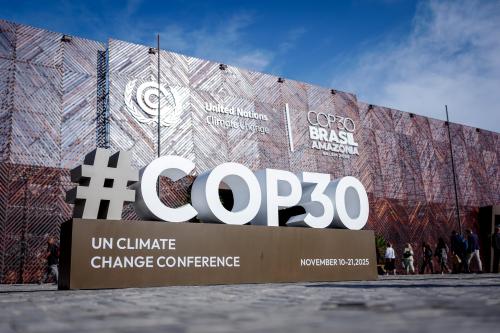The ending of climate negotiations last week in Lima was remarkably positive, given that as late as the morning before many challenges still seemed almost insurmountable. The final draft agreement may not be strong, but it does point the way towards a deal that will be decided this time next year in Paris. This glass is half full, because it has to be.
Sitting at the crowded gate in the Lima, Peru airport just before midnight Saturday, my students and I eagerly checked Twitter for notification of a new draft of the agreement—one which we had spent the week struggling to understand. Tory Hoffmeister had spent hours building a table of who had supported and who opposed which elements of key earlier drafts of the agreement.
Bringing a group of college students to watch the global climate change policy sausage-making process is a risky psychological undertaking. Young people are desperate to see progress in how humanity solves this wickedly complex problem. Witnessing the process in person can be very instructive, but also quite depressing.
Deep divisions between views of what would be a fair solution to the problem make the process sometimes nasty and demoralizing. The constant drumbeat of critique on the web and in the “Twittersphere” made it difficult to get a bigger picture of what, if anything, was being accomplished. And as the two-week negotiations went on, each draft of the agreement seemed weaker and more confusing than the last. Each time, the lead negotiators seemed to be choosing the lowest common denominator.
Worst of all was the penultimate draft of Saturday morning, which held an extremely weak set of positions on what nations would even report to the U.N. about their planning for reducing emissions. The world seemed split sharply between a resigned but positive set of “global north” countries that supported adopting the draft and an angry developing world that found it unacceptable. Only the AILAC group of Latin American countries (Independent Association of Latin America and the Caribbean) and a few island nations broke ranks from the southern bloc, saying that it was too important to leave Lima without an agreement.
As the negotiations—at a repurposed army base in the San Borga neighborhood of Lima—went into overtime, the ranks were thinning of observers from environmental NGOs, think tanks, and universities. Still, the Twittersphere was abuzz as the negotiations went through 24 hours of overtime, and a protest flared up by some civil society groups still at the venue as they awaited the same final text we did.
“No justice, no deal” read their banner; “Fight for climate justice!” read another in Spanish.
But this year was quite typical in this respect. The lowest point is always just before the finish, and some important and positive things took place at the very end. Just before midnight Saturday, a day after the U.N. climate negotiations were supposed to have ended, the Peruvian president of the meeting Manuel Pulgar-Vidal announced the new final draft was up on the web, and gave all the countries of the world an hour to review it. Just moments before they called our rows, we downloaded the still unnumbered PDF, and boarded.
Unable to sleep on the all-night flight home, there was time to review the piece as a whole, without the chatter of the Twittersphere or voices of the mainstream media. To my surprise, several new paragraphs had appeared in the text—paragraphs that had been clamored for by developing countries. Several other desired paragraphs were still missing. The end results was not strong enough to protect our species from dangerous climate change, but it did not amount to nothing either.
The final Lima agreement expressed alarm over the likely temperature rise beyond safe levels if we do not sharply advance our ambition on this issue. The agreement is new because now all nations will submit reports on their “Intended Nationally-Determined Contributions,” or INDCs. In the past, only the historically wealthy OECD nations had responsibilities to reduce emissions. These INDCs will cover many issues, such as reducing emissions, but also they can report how a country will adapt to climate impacts, and what they could do if they had more funding and technical support.
There are many weak areas of the text. Perhaps the most important is the lack of any certain public funding support for developing nations to reduce their emissions and to prepare for future climate-related disasters. One of the many pieces that should have been in the text but was not, was how that funding will be generated, and who will deliver it. There is nothing binding in the document covering the “loss and damage” mechanism so desperately desired by developing countries. Most crucially, the whole process is now about voluntary pledges by nations, not any rational sharing of the remaining “atmospheric space” available before we seriously damage the climate.
So the U.N. climate glass can be seen as half empty or half full as the Lima year comes to a close. The final draft agreement may not be strong, but it does point the way towards a deal that will be decided this time next year in Paris. That deal will set the course to a set of reporting by nations on what they will do by 2020 to slow global warming.
The focus now can shift back to the national capitals, as major economies will need to release their INDC plans on climate by March 2015. The rest of the world has a deadline of October 1. By November 1 we will have a report back from the U.N. about what the INDC plans collectively add up to. That leaves just a few weeks of crunch time to prepare for the big negotiations in Paris next December.
December 2015 is the deadline for an agreement that will have targets for emissions levels that countries are pledging to meet by 2020. Contrary to many people’s understanding, this five-year lag does not mean that nations can do nothing for those five years. To the contrary—nations will have to be on their pathway to lowering their emissions over those years so they can hit their target by then.
The ending at Lima was remarkably positive, given that just the morning before, a lead negotiator was imploring parties to not throw the whole thing out but to suggest small surgical changes, not to “turn a circumcision into an amputation.” The lead U.S. negotiator Todd Stern warned then that if the group failed, the future of the U.N. process was at stake and “We will regret if we let the perfect be the enemy of the good in Lima.”
Landing in the U.S. on Sunday morning, it was clear that in the end, not much was achieved in Lima, and nearly all the tough issues had been kicked down the road to the 2015 Paris round. Piles of fascinating and thorny issues lie in a “parking lot” compilation document called “Elements of an Agreement” which was never negotiated in Lima.
Still, for me the glass is half full, both because the ending was more positive than we feared, but also because it literally has to be: the process is moving forward, and much will become clear as nations finalize plans this year. There will need to be careful scrutiny of national plans, and pressure from civil society and scientists to make sure that nations are doing all they can, and all they must, to stop from damaging our future prospects. There is a place for all of us, even university students and professors, in making sure that happens.
The Brookings Institution is committed to quality, independence, and impact.
We are supported by a diverse array of funders. In line with our values and policies, each Brookings publication represents the sole views of its author(s).



Commentary
Finding Hope and a Glass Half Full at the Climate Talks in Lima
December 15, 2014